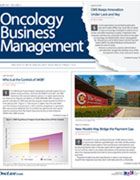Publication
Article
Special Issues
Bundles Offer Better Outcomes and Savings
Author(s):
The primary goal of a cancer diagnosis is to end up with the best possible outcome, and there are always several highways of care, or bundles, to choose from.
Andrew L. Pecora, MD
Imagine you are sitting at the kitchen table and planning a road trip with your family. Although the French toast is important, deciding where to go is critical. There are always several major highways from which to choose, and once you are on the road, you will need to choose your driving lane.
What does this have to do with healthcare and the move to value from fee-for-service volume billing? Everything! In healthcare, the journey starts not at the kitchen table but in a doctors’ office, when you receive a diagnosis. The primary goal is to end up with the best possible outcome, and there are always several highways of care—bundles—to choose from.
Bundles enable patients to obtain more intense and costly therapy if they need it. Next, the precise type and sequence of treatment—lanes—must be chosen from within each bundle. For each patient, providers must aim to select the bundle and the lane within the bundle that offer the best possible outcome.
For the sum of patients treated within a bundle, the goal is to obtain the lowest possible overall cost. This is because patients who need less are placed into lanes of care that cost less. In summary, all patients achieve the best clinical outcomes when care is tailored to their individual needs, and the total cost of care should be less for the entire population.
Regional Cancer Care Associates, a large New Jersey oncology group, of which I am a member, is working on this type of value-guided care in partnership with Horizon Blue Cross and Cota, a precision analytics company. In addition, the Large Urology Group Practice Association has announced a prostate bundling initiative in collaboration with Integra Connect. Be sure to read this month’s cover story about bundled care and alternative payment models.
CMS is working to encourage the adoption of value-based care models specifically because of the potential for improved outcomes and lower costs. Achieving these goals will take time, but we have to do it if we truly want to fix healthcare. I believe that in the not-so-distant future patients and doctors will have the information they need to choose the correct bundles and lanes that make the best sense. Exactly as it is when planning a family road trip, the most efficient path forward eventually will become clear.
Getting to that point will require a consensus among all stakeholders, which may not be easy to achieve. Patients will emphasize the importance of a good health outcome. For them, the cost of care will be a lesser concern. Doctors will focus on health outcomes and will consider doing less and making less money. Payers will focus on total cost and put clinical outcomes and satisfaction second. Finally, life science companies will be most interested in financial return and less concerned about drug efficacy and the cost of therapy.









